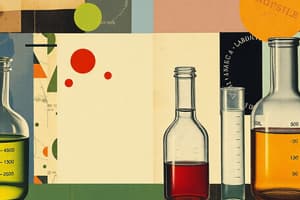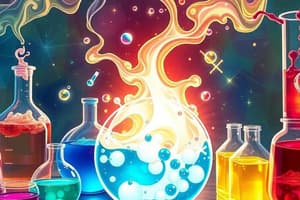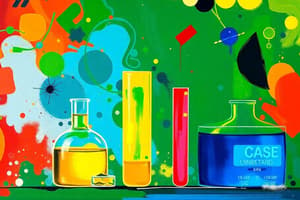Podcast
Questions and Answers
______ indicators change color to show if a substance is acidic or basic.
______ indicators change color to show if a substance is acidic or basic.
Acid-base
The acids provided include hydrochloric acid (HCl), sulphuric acid (H2SO4), and ______ acid (HNO3).
The acids provided include hydrochloric acid (HCl), sulphuric acid (H2SO4), and ______ acid (HNO3).
nitric
______ indicators are substances whose odor changes in acidic or basic media.
______ indicators are substances whose odor changes in acidic or basic media.
Olfactory
Litmus paper turns ______ in acidic solutions.
Litmus paper turns ______ in acidic solutions.
Sodium hydroxide (______) is a common base.
Sodium hydroxide (______) is a common base.
______ orange is an indicator used to test for acids and bases.
______ orange is an indicator used to test for acids and bases.
Acetic acid has the chemical formula ______.
Acetic acid has the chemical formula ______.
______ hydroxide [Ca(OH)2] is a base.
______ hydroxide [Ca(OH)2] is a base.
When testing solutions, a drop of each solution is placed on a ______.
When testing solutions, a drop of each solution is placed on a ______.
Ammonium hydroxide has the formula ______.
Ammonium hydroxide has the formula ______.
In the lab, acids and bases can be identified using indicators which change ______ in response to the substance's properties.
In the lab, acids and bases can be identified using indicators which change ______ in response to the substance's properties.
If you have only red litmus paper, you can identify an acidic solution because it will ______ the red litmus paper.
If you have only red litmus paper, you can identify an acidic solution because it will ______ the red litmus paper.
To identify a base using only red litmus paper, the base will ______ the red litmus paper.
To identify a base using only red litmus paper, the base will ______ the red litmus paper.
When testing solutions, a drop of each is placed on a ______ before adding indicators.
When testing solutions, a drop of each is placed on a ______ before adding indicators.
An acidic solution will ______ blue litmus paper, but a basic solution will turn red litmus paper blue.
An acidic solution will ______ blue litmus paper, but a basic solution will turn red litmus paper blue.
The provided solutions in the lab include both strong acids like hydrochloric acid ($HCl$) and weak acids like ______
The provided solutions in the lab include both strong acids like hydrochloric acid ($HCl$) and weak acids like ______
In addition to acids, the lab provides strong bases like sodium hydroxide ($NaOH$) and weaker bases like ______.
In addition to acids, the lab provides strong bases like sodium hydroxide ($NaOH$) and weaker bases like ______.
Using cloth strips soaked with chopped onions to indicate acids and bases makes use of ______ indicators.
Using cloth strips soaked with chopped onions to indicate acids and bases makes use of ______ indicators.
To properly use olfactory indicators, the bag with onions and cloth strips needs to sit ______ in the fridge.
To properly use olfactory indicators, the bag with onions and cloth strips needs to sit ______ in the fridge.
The change in ______ is how indicators show whether a substance is acidic or basic.
The change in ______ is how indicators show whether a substance is acidic or basic.
[Blank] indicators are substances that exhibit a change in odour when exposed to acidic or basic media.
[Blank] indicators are substances that exhibit a change in odour when exposed to acidic or basic media.
When testing solutions with litmus paper, acids cause blue litmus to turn ______.
When testing solutions with litmus paper, acids cause blue litmus to turn ______.
In an experiment, if red litmus paper remains red upon contact with a solution, it indicates that the solution is either acidic or ______.
In an experiment, if red litmus paper remains red upon contact with a solution, it indicates that the solution is either acidic or ______.
To distinguish between distilled water, an acidic solution, and a basic solution using only red litmus paper, you would first identify the ______ solution, which turns red litmus blue.
To distinguish between distilled water, an acidic solution, and a basic solution using only red litmus paper, you would first identify the ______ solution, which turns red litmus blue.
After identifying the basic solution, one can identify the acidic solution by using the now-blue litmus paper and observing which solution turns it ______.
After identifying the basic solution, one can identify the acidic solution by using the now-blue litmus paper and observing which solution turns it ______.
Phenolphthalein remains ______ in acidic solutions but turns pink in basic solutions, providing a distinct visual indicator.
Phenolphthalein remains ______ in acidic solutions but turns pink in basic solutions, providing a distinct visual indicator.
Methyl orange turns ______ in acidic solutions and yellow in basic solutions, offering another method for differentiating between acids and bases.
Methyl orange turns ______ in acidic solutions and yellow in basic solutions, offering another method for differentiating between acids and bases.
When testing with olfactory indicators, a strong onion smell might be masked or altered in the presence of a ______ due to chemical reactions.
When testing with olfactory indicators, a strong onion smell might be masked or altered in the presence of a ______ due to chemical reactions.
The characteristic reaction of acids with litmus paper is due to the presence of ______ ions, which are responsible for their acidic properties.
The characteristic reaction of acids with litmus paper is due to the presence of ______ ions, which are responsible for their acidic properties.
When using only red litmus paper to differentiate between distilled water, an acidic solution, and a basic solution, the basic solution is identified by its ability to turn the red litmus paper ______, after which the solution that does not alter the blue litmus paper formed is identified as distilled water.
When using only red litmus paper to differentiate between distilled water, an acidic solution, and a basic solution, the basic solution is identified by its ability to turn the red litmus paper ______, after which the solution that does not alter the blue litmus paper formed is identified as distilled water.
Acetic acid, represented by the chemical formula CH3COOH, exhibits its acidic properties due to the presence of a ______ that can be donated to a base in a chemical reaction.
Acetic acid, represented by the chemical formula CH3COOH, exhibits its acidic properties due to the presence of a ______ that can be donated to a base in a chemical reaction.
The utility of olfactory indicators, such as finely chopped onions, in identifying acidic or basic media relies on the change in their ______ when exposed to these substances.
The utility of olfactory indicators, such as finely chopped onions, in identifying acidic or basic media relies on the change in their ______ when exposed to these substances.
In the context of acid-base chemistry, phenolphthalein serves as an indicator that transitions from colorless to ______ in the presence of a base, signaling a pH shift above its characteristic range.
In the context of acid-base chemistry, phenolphthalein serves as an indicator that transitions from colorless to ______ in the presence of a base, signaling a pH shift above its characteristic range.
Methyl orange exhibits its color change within a specific pH range, transitioning from red in acidic conditions to ______ in alkaline conditions, thereby indicating the acidity or basicity of a solution.
Methyl orange exhibits its color change within a specific pH range, transitioning from red in acidic conditions to ______ in alkaline conditions, thereby indicating the acidity or basicity of a solution.
When hydrochloric acid (HCl) reacts with sodium hydroxide (NaOH), the resulting products are sodium chloride (NaCl) and water (H2O), illustrating a classic ______ reaction.
When hydrochloric acid (HCl) reacts with sodium hydroxide (NaOH), the resulting products are sodium chloride (NaCl) and water (H2O), illustrating a classic ______ reaction.
The strength of an acid or a base, quantified by its dissociation constant, determines its ability to ______ ions in solution, influencing its reactivity and impact on pH levels.
The strength of an acid or a base, quantified by its dissociation constant, determines its ability to ______ ions in solution, influencing its reactivity and impact on pH levels.
Ammonium hydroxide (NH4OH), a weak base, only partially ionizes in water to form ammonium ions (NH4+) and hydroxide ions (OH-), leading to a ______ pH compared to strong bases.
Ammonium hydroxide (NH4OH), a weak base, only partially ionizes in water to form ammonium ions (NH4+) and hydroxide ions (OH-), leading to a ______ pH compared to strong bases.
Calcium hydroxide, also known as slaked lime, has the chemical formula ______.
Calcium hydroxide, also known as slaked lime, has the chemical formula ______.
Sulphuric acid (H2SO4), known for its corrosive nature and extensive industrial applications, is a ______ acid that readily donates protons in chemical reactions.
Sulphuric acid (H2SO4), known for its corrosive nature and extensive industrial applications, is a ______ acid that readily donates protons in chemical reactions.
If provided with only red litmus paper, one can identify an acidic solution because it will ______ the red litmus paper.
If provided with only red litmus paper, one can identify an acidic solution because it will ______ the red litmus paper.
Substances whose odor changes in acidic or basic media are called ______ indicators.
Substances whose odor changes in acidic or basic media are called ______ indicators.
The chemical formula for sulfuric acid is ______.
The chemical formula for sulfuric acid is ______.
A base will turn red litmus paper ______.
A base will turn red litmus paper ______.
The chemical name for $CH_3COOH$ is ______ acid.
The chemical name for $CH_3COOH$ is ______ acid.
When testing solutions with phenolphthalein, a ______ color indicates a basic solution.
When testing solutions with phenolphthalein, a ______ color indicates a basic solution.
Distilled water is considered ______ and will not change the color of either red or blue litmus paper.
Distilled water is considered ______ and will not change the color of either red or blue litmus paper.
Methyl orange turns ______ in acidic solutions.
Methyl orange turns ______ in acidic solutions.
Ammonium hydroxide, represented by the chemical formula $NH_4OH$, is classified as a weak ______.
Ammonium hydroxide, represented by the chemical formula $NH_4OH$, is classified as a weak ______.
To enhance the sensitivity of olfactory indicators like chopped onions, one might consider using a ______ environment to minimize interference from ambient odors. This is an insanely difficult question!
To enhance the sensitivity of olfactory indicators like chopped onions, one might consider using a ______ environment to minimize interference from ambient odors. This is an insanely difficult question!
Flashcards
Litmus Test
Litmus Test
A method to identify acidic or basic solutions using litmus paper.
Red Litmus Paper
Red Litmus Paper
Indicator that turns blue in basic solutions and stays red in acids.
Blue Litmus Paper
Blue Litmus Paper
Indicator that turns red in acidic solutions and stays blue in bases.
Acidic Solutions
Acidic Solutions
Signup and view all the flashcards
Basic Solutions
Basic Solutions
Signup and view all the flashcards
Olfactory Indicators
Olfactory Indicators
Signup and view all the flashcards
Examples of Acids
Examples of Acids
Signup and view all the flashcards
Examples of Bases
Examples of Bases
Signup and view all the flashcards
Phenolphthalein
Phenolphthalein
Signup and view all the flashcards
Methyl Orange
Methyl Orange
Signup and view all the flashcards
Testing Solutions
Testing Solutions
Signup and view all the flashcards
Indicators
Indicators
Signup and view all the flashcards
Red Litmus Reaction
Red Litmus Reaction
Signup and view all the flashcards
Basic pH
Basic pH
Signup and view all the flashcards
Acidic pH
Acidic pH
Signup and view all the flashcards
Phenolphthalein Color Change
Phenolphthalein Color Change
Signup and view all the flashcards
Methyl Orange Color Change
Methyl Orange Color Change
Signup and view all the flashcards
Laboratory Activity
Laboratory Activity
Signup and view all the flashcards
Olfactory Indicators Usage
Olfactory Indicators Usage
Signup and view all the flashcards
Acid and Base Examples
Acid and Base Examples
Signup and view all the flashcards
Identifying Test Tubes
Identifying Test Tubes
Signup and view all the flashcards
Indicators Test Color Change
Indicators Test Color Change
Signup and view all the flashcards
Testing with Phenolphthalein
Testing with Phenolphthalein
Signup and view all the flashcards
Observing Color with Methyl Orange
Observing Color with Methyl Orange
Signup and view all the flashcards
Reaction of Red Litmus
Reaction of Red Litmus
Signup and view all the flashcards
Using Chopped Onions
Using Chopped Onions
Signup and view all the flashcards
Hydrochloric Acid
Hydrochloric Acid
Signup and view all the flashcards
Role of Sodium Hydroxide
Role of Sodium Hydroxide
Signup and view all the flashcards
Olfactory Indicators Defined
Olfactory Indicators Defined
Signup and view all the flashcards
Phenolphthalein Usage
Phenolphthalein Usage
Signup and view all the flashcards
Identifying Test Tubes with Red Litmus
Identifying Test Tubes with Red Litmus
Signup and view all the flashcards
Laboratory Activity with Solutions
Laboratory Activity with Solutions
Signup and view all the flashcards
Color Change Observations
Color Change Observations
Signup and view all the flashcards
Testing with Methyl Orange
Testing with Methyl Orange
Signup and view all the flashcards
Indicators and Acidity
Indicators and Acidity
Signup and view all the flashcards
Common Acid Examples
Common Acid Examples
Signup and view all the flashcards
Common Base Examples
Common Base Examples
Signup and view all the flashcards
Identifying Acidic Solutions
Identifying Acidic Solutions
Signup and view all the flashcards
Identifying Basic Solutions
Identifying Basic Solutions
Signup and view all the flashcards
Olfactory Indicators Identified
Olfactory Indicators Identified
Signup and view all the flashcards
Testing with Onions
Testing with Onions
Signup and view all the flashcards
Color Change in Phenolphthalein
Color Change in Phenolphthalein
Signup and view all the flashcards
Color Change in Methyl Orange
Color Change in Methyl Orange
Signup and view all the flashcards
Observing Indicators
Observing Indicators
Signup and view all the flashcards
Testing Methodology
Testing Methodology
Signup and view all the flashcards
Collecting Solutions
Collecting Solutions
Signup and view all the flashcards
Understanding Test Tube Contents
Understanding Test Tube Contents
Signup and view all the flashcards
Study Notes
Acids and Bases in the Laboratory
- Collect solutions: Hydrochloric acid (HCl), sulfuric acid (H₂SO₄), nitric acid (HNO₃), acetic acid (CH₃COOH), sodium hydroxide (NaOH), calcium hydroxide [Ca(OH)₂], potassium hydroxide (KOH), magnesium hydroxide [Mg(OH)₂], and ammonium hydroxide (NH₄OH).
- Test solutions: Use red litmus, blue litmus, phenolphthalein, and methyl orange solutions to test each solution.
- Observe changes: Note any color changes in the indicators.
- Record observations: Tabulate the observations in a table (see Table 2.1 in the text).
- Solutions from three test tubes can be categorized by testing their properties with the use of red litmus paper.
Olfactory Indicators
- Substances with changing odors in acidic or basic media are called olfactory indicators.
- Use cloth strips soaked in the solution to test odors.
- Test with HCl and NaOH: Check the odors of strips with HCl and NaOH (after soaking cloth strips).
- Onion example: Finely chopped onions, placed in a plastic bag with clean cloth strips, placed in the fridge overnight, can be used as an olfactory indicator for acids and bases.
- Cloth preparation: Take some finely chopped onions in a plastic bag along with strips of clean cloth. Tie the bag tightly and leave overnight in the fridge.
- Test cloth strips: Take two of these cloth strips and check their odor.
Studying That Suits You
Use AI to generate personalized quizzes and flashcards to suit your learning preferences.




